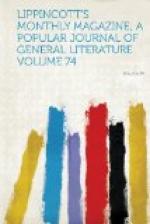We stopped at the office of our banker for a moment on our way along the Chandni Chowk in order to effect some changes of money. As we were leaving, Bhima Gandharva inquired if I had observed the young man in the red cotton turban who had politely broken off in our favor a long negotiation with our banker, which he resumed when we had finished our little business.
“Of course I did,” I replied. “What a beautiful young man he was! His aquiline nose, his fair complexion, his brilliant eyes, his lithe form, his intelligent and vivacious expression,—all these irresistibly attracted me to him.”
“Ha!” said Bhima Gandharva, as if he were clearing his throat. He grasped my arm: “Come, I thought I saw the young man’s father standing near the door as we passed out. I wonder if he will irresistibly attract you?” He made me retrace my steps to the banker’s office: “There he is.”
He was the image of the son in feature, yet his face was as repulsive as his son’s was beautiful: the Devil after the fall, compared with the angel he was before it, would have presented just such a contrast.
“They are two Vallabhacharyas,” said my companion as we walked away. “You know that the trading community of India, comprehended under the general term of Baniahs, is divided into numerous castes, which transmit their avocations from father to son and preserve themselves free from intermixture with others. The two men you saw are probably on some important business negotiation connected with Bombay or the west of India; for they are Bhattias, who are also followers of the most singular religion the world has ever known—that of the Vallabhacharya or Maharaja sect. These are Epicureans who have quite exceeded, as well in their formal creeds as in their actual practices, the wildest dreams of any of those mortals who have endeavored to make a religion of luxury. They are called Vallabhacharyas, from Vallabha, the name of their founder, who dates from 1479, and acharya, a “leader.” Their Pushti Marga, or eat-and-drink doctrine, is briefly this: In the centre of heaven (Gouloka) sits Krishna, of the complexion of a dark cloud, clad in yellow, covered with unspeakable jewels, holding a flute. He is accompanied by Roaha, his wife, and also by three hundred millions of Gopis, or female




